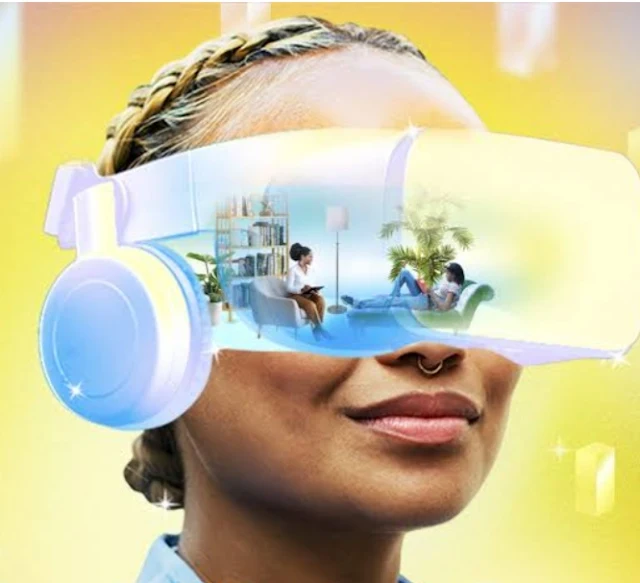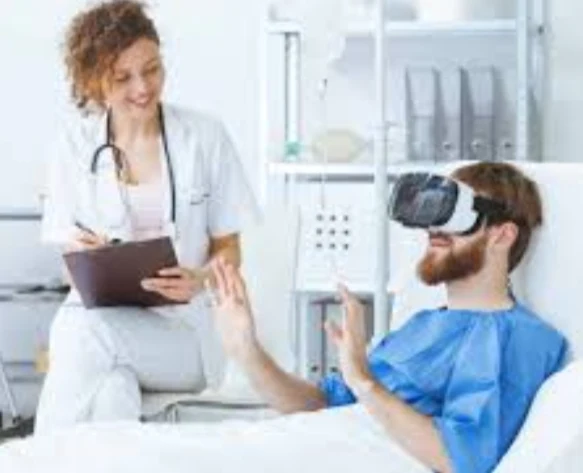Virtual Reality Exposure Therapy (VR)
Virtual Reality Exposure Therapy (VR) is a cutting-edge therapeutic technique that combines exposure therapy with virtual reality (VR) technology. It's designed to help individuals confront their fears and anxieties in a safe, controlled virtual environment.
Current Projects in Virtual Reality Exposure Therapy (VR)
Here's a table outlining some ongoing and recently completed projects utilizing VR exposure therapy:
| Project Name/Institution | Target Condition(s) | Description | Outcomes/Progress |
|---|---|---|---|
| Bravemind (NIMH)** | Post-Traumatic Stress Disorder (PTSD) in military personnel | This project by the National Institute of Mental Health (NIMH) in the US utilizes VR to create scenarios related to combat stress. Soldiers can confront virtual environments that evoke memories in a safe, controlled setting. | Initial trials have shown promise in reducing PTSD symptoms in veterans. https://www.soldierstrong.org/bravemind/ |
| 恐惧克服 (FearOvercome) by Roche VR | Phobias (spiders, heights, public speaking) | Developed by a pharmaceutical company, FearOvercome uses VR to expose patients to their phobias in a gradual manner. The program offers customizable virtual environments and therapist-guided sessions. | Studies suggest FearOvercome is effective in reducing phobic responses and anxiety. https://varjo.com/case-studies/how-lucid-reality-labs-and-roche-raise-awareness-for-macular-disease-with-varjo-mixed-reality/ |
| GAIN (Gamified Addiction Intervention Network) by University of Southern California (USC) | Substance Use Disorders (SUDs) | This project by USC's Institute for Creative Technologies leverages VR to create scenarios that challenge users' cravings and teach them coping skills to resist substance abuse. | Initial trials indicate GAIN can be a useful tool for addiction treatment, particularly alongside traditional therapy. https://ias.usc.edu/ |
| Virtual Reality Therapy for Chronic Pain by Cedars-Sinai Medical Center | Chronic Pain Management | This program uses VR to distract patients from chronic pain by placing them in immersive, relaxing environments. It also incorporates biofeedback mechanisms to help patients manage their pain response. | Studies have shown VR therapy can be effective in reducing chronic pain perception and improving pain management skills. https://www.cedars-sinai.org/newsroom/cedars-sinai-study-finds-virtual-reality-therapy-helps-decrease-pain-in-hospitalized-patients/ |
Please note: This table is not exhaustive and represents just a few examples of the many VR exposure therapy projects underway. The field is constantly evolving with new applications and areas of exploration emerging.
How VR Exposure Therapy Works
Traditional exposure therapy involves gradually exposing patients to their phobias or anxieties in real-life situations. VR exposure therapy replicates this process within a virtual world. Here's a breakdown of the process:
- Assessment: The therapist will first assess the patient's specific fears and anxiety triggers.
- Creating the Virtual Environment: The therapist will then work with a VR program to create a customized virtual environment that mirrors the patient's phobic situations. This could be anything from a crowded elevator to a public speaking engagement.
- Gradual Exposure: The patient, under the therapist's guidance, will be gradually exposed to the virtual environment. The therapist can control the intensity and duration of the exposure, allowing the patient to progress at their own pace.
- Learning Coping Mechanisms: Throughout the VR experience, the therapist will teach the patient coping skills to manage their anxiety in the virtual environment. These skills can then be applied to real-life situations.
Conditions Treated with VR Exposure Therapy
VR exposure therapy has been shown to be effective in treating a wide range of phobias and anxiety disorders, including:
- Phobias (e.g., spiders, heights, public speaking)
- Post-traumatic stress disorder (PTSD)
- Social anxiety disorder
- Obsessive-compulsive disorder (OCD)
Benefits of VR Exposure Therapy
VR exposure therapy offers several advantages over traditional exposure therapy:
- Safe and Controlled Environment: VR allows patients to confront their fears in a safe and controlled setting, minimizing the risk of panic or anxiety attacks.
- Increased Engagement: The immersive nature of VR can make exposure therapy more engaging and motivating for patients.
- Customization: VR environments can be tailored to each patient's specific needs and anxieties.
- Accessibility: VR exposure therapy can be used to provide treatment to patients who may not have access to real-life exposure opportunities.
Table: Comparison of Traditional Exposure Therapy vs. VR Exposure Therapy
| Feature | Traditional Exposure Therapy | VR Exposure Therapy |
|---|---|---|
| Environment | Real-life situations | Virtual reality environment |
| Control | Limited control over exposure | Therapist can control intensity and duration of exposure |
| Accessibility | May be limited by real-world situations | More accessible, regardless of location |
| Engagement | May be less engaging for some patients | More immersive and engaging experience |
While VR exposure therapy is a promising new treatment option, it's important to note that it's not a replacement for traditional therapy. It's most effective when used in conjunction with other therapeutic techniques.
Technological Advancements in Virtual Reality Exposure Therapy (VR)
Virtual Reality Exposure Therapy (VR) has become a revolutionary tool in mental health treatment. By harnessing the power of technology, VR creates safe and controlled environments for individuals to confront their fears and anxieties. But what specific technologies are driving this therapeutic revolution? Let's delve into the technological foundation of VR exposure therapy.
Core Technologies
-
Virtual Reality Headsets (VR HMDs): These are the most recognizable elements of VR. HMDs completely immerse users in a computer-generated world by blocking out external sights and sounds. Modern HMDs offer high-resolution visuals, head tracking for a natural perspective shift, and some even incorporate haptic feedback for a more realistic touch experience.
-
3D Modeling and Game Engines: Creating believable virtual environments is crucial for VR exposure therapy. 3D modeling software allows therapists and developers to craft detailed virtual landscapes, objects, and characters. Powerful game engines like Unity or Unreal Engine provide the foundation for building interactive virtual experiences tailored to specific phobias or anxieties.
-
Biofeedback Sensors: These sensors monitor a patient's physiological responses during VR exposure, such as heart rate, skin conductance, and muscle tension. This real-time data helps therapists gauge a patient's anxiety levels and adjust the intensity of the virtual experience accordingly.
-
Motion Tracking Systems: These systems track a patient's movements within the virtual environment. This allows for a more natural and interactive experience, where a patient's actions within the VR world have consequences, further enhancing the therapeutic effect.
Table: Technological Uses in VR Exposure Therapy
| Technology | Function | Benefit |
|---|---|---|
| VR Headsets (VR HMDs) | Provide complete visual and auditory immersion | Creates a realistic and engaging virtual environment |
| 3D Modeling & Game Engines | Design and build virtual environments | Allows for customization of scenarios to target specific phobias |
| Biofeedback Sensors | Monitor physiological responses | Enables therapists to adjust exposure intensity based on real-time anxiety levels |
| Motion Tracking Systems | Track user movement within VR | Enhances user interaction and creates a more natural experience |
The Future of VR Technology in Therapy
The field of VR therapy is constantly evolving. We can expect advancements in:
- Haptic Technology: Providing a more realistic sense of touch within VR environments.
- Olfactory Technology: Introducing smells to further immerse patients in virtual scenarios.
- Artificial Intelligence (AI): Personalizing VR experiences based on a patient's progress and emotional state.
These advancements hold the promise of even more effective and engaging VR exposure therapy, leading to improved mental health outcomes for a wider range of patients.
Frequently Asked Questions for Virtual Reality Exposure Therapy (VR-E)
Virtual Reality Exposure Therapy (VR-E) is a therapeutic technique used to treat phobias and anxiety disorders. It involves exposing patients to simulated situations that trigger their fear or anxiety in a controlled virtual environment.
General Questions
- What is VR-E?
- VR-E is a form of exposure therapy that uses virtual reality technology to gradually expose patients to their fears in a safe and controlled setting.
- How does VR-E work?
- During VR-E sessions, patients wear a VR headset and are immersed in a simulated environment that triggers their fear. A therapist guides them through the exposure, gradually increasing the intensity of the fear-inducing stimuli.
- What conditions can VR-E be used to treat?
- VR-E has been shown to be effective in treating various anxiety disorders, including:
- Phobias (e.g., fear of heights, spiders, flying)
- Post-traumatic stress disorder (PTSD)
- Panic disorder
- Obsessive-compulsive disorder (OCD)
- VR-E has been shown to be effective in treating various anxiety disorders, including:
Technical Questions
- What equipment is needed for VR-E?
- A VR headset, a computer or gaming console, and specialized VR-E software are required for VR-E therapy.
- How realistic are the virtual environments used in VR-E?
- VR-E technology has advanced significantly, allowing for highly realistic and immersive virtual environments.
- Can VR-E be used at home?
- While some VR-E applications can be used at home, it is generally recommended to undergo therapy with a qualified mental health professional to ensure proper guidance and support.
Benefits and Challenges
- What are the benefits of VR-E compared to traditional exposure therapy?
- VR-E offers several advantages, including:
- Controlled environment: VR-E allows for precise control over the exposure stimuli.
- Repeated exposure: Patients can be repeatedly exposed to their fears in a safe and controlled setting.
- Reduced cost: VR-E can be less expensive than traditional exposure therapy.
- What are the challenges of VR-E?
- Technological limitations: VR technology may still have limitations in terms of realism and user comfort.
- Individual differences: VR-E may not be effective for everyone, and individual responses may vary.
- Accessibility: VR headsets can be expensive, making VR-E less accessible to some individuals.
- VR-E offers several advantages, including:


